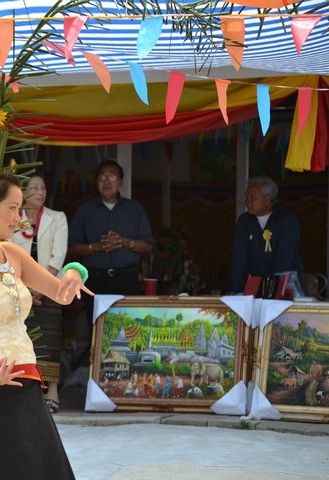The current scene in art fairs creates a bewildering spectacle, but this is similar to my critique of Southeast Asian open mikes of the 2000s. You could run into plenty of people who claim they had an amazing experience seeing so many artists at once. But dollars to doughnuts, they couldn't name a single one of the artists or quote a truly memorable line that was going to stick with them past the weekend.
Considering how often Asian Americans and particularly Asian American artists have to confront the yellow horde 'all-look-alike' stereotype, I consider this problematic. That's not going to stop people from thinking six to a dozen or hundreds of artists performing is an amazing draw, but I think it's a road to diminishing returns, and I try to avoid those now.
There aren't many events that are centered on the idea of an Asian American Arts Fair. Asian American film festivals are popular, but visual art alone is not often presented in our communities, especially among the Lao in America.
Often, I'm left appalled at events where the vendors have no respect for the art they want others to buy. To them, it's just another commodity that might as well be some crude wood crate as something valuable for another person to buy and take home with them.
They don't know how to teach appreciation for a particular work or to show people the story behind a particular piece. They just set it on the ground, then scratch their heads when they have to take it back home because no one thought it's worth anything to buy.

Another dangerous scenario for our visual artists is that none of their pieces will receive serious consideration unless it is ridiculously outrageous and transgressive to the point of self-parody.
I would lament that a good majority of capable Lao American visual artists are pandering to the lowest denominator with unoriginal perspectives and vantage points, staid, conservative depictions of everyday Lao life. Works that make no statements. They may as well be a pier caricaturist. And each year, they bring the same images to the table, so we have no sense of growth, no sense of innovation or excitement. And why should a visual artist step into that?
For Lao American arts to flourish, however demanding, thoughtful, critical consideration for individual artists and their bodies of work is exactly what we need as a community. This cannot be accomplished simply by remarking on the artist fair and festival as a whole.
I imagine this will fall on deaf ears but for future event organizers considering a Lao American artist exhibition, we need to remember that the art journalists and critics are pressed for time and will be tempted to write up the event as commercial spectacles, not as a thoughtful, carefully curated exhibition.
Bearing all of this in mind, we should be developing an approach that allows the critics and writers to engage with the artists, and to give space and coverage to what a particular piece can mean. Otherwise, we position Lao American art dangerously as a body of work whose value is determined only by collectors, and as a question of price. Sales will be considered the determination of success.
The work does not gain value because an intelligent and spirited debate has ensued, because someone has been inspired or seen the world differently from what the artist created, but because someone has decided to pay money for it, hoping someone else will buy it off of them later. This is a repellent approach to the matter.
I imagine this will fall on deaf ears but for future event organizers considering a Lao American artist exhibition, we need to remember that the art journalists and critics are pressed for time and will be tempted to write up the event as commercial spectacles, not as a thoughtful, carefully curated exhibition.
Bearing all of this in mind, we should be developing an approach that allows the critics and writers to engage with the artists, and to give space and coverage to what a particular piece can mean. Otherwise, we position Lao American art dangerously as a body of work whose value is determined only by collectors, and as a question of price. Sales will be considered the determination of success.
The work does not gain value because an intelligent and spirited debate has ensued, because someone has been inspired or seen the world differently from what the artist created, but because someone has decided to pay money for it, hoping someone else will buy it off of them later. This is a repellent approach to the matter.
No comments:
Post a Comment